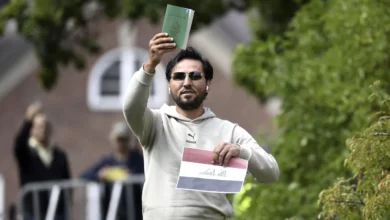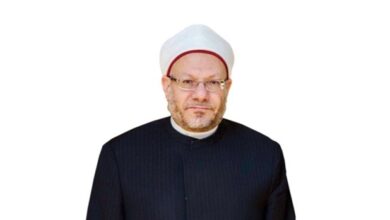Artist Andrew Kosorok has a three-year plan. Using glass as a primary medium, he is creating 99 sculptures, each reflecting one of the names of God written in the Quran. It is a work of dedication reminiscent of the devoted Muslim’s quest to memorize each name, but Kosorok is not a Muslim. Raised in Washington State, he moved to Salt Lake City, Utah to attend school, and remained to teach, work, and raise a family. Kosorok is a member of the Church of Latter Day Saints (LDS); his holy book is not the Quran, but the Book of Mormon.
Mormonism–the branch of LDS with the most followers–is a Christian denomination with a relatively recent genesis. Founded in New York in the 1820s by Joseph Smith, Mormons believe that their teachings restore a flawed Christianity to its primitive ideals. Considered subversive, followers quickly left for areas in the United States where their divergent faith would be accepted. Although Mormonism today is a minority religion in most of the U.S., they constitute the majority in Salt Lake City, and Kosorok, like many Salt Lake City transplants, moved to the Mormon center because it felt “safe.” He wrote his thesis, at Brigham Young University (which attracts a largely Mormon population), on the “Ultimate Truth,” not, he says, in order to define it, but to “show how cultures and faiths approach such an ideal.”
Islam might seem an unlikely focus for an artist of such a specific faith living in an insular location according to that faith, but Mormonism and Islam have a something in common beyond theological overlap, which is significant. Culturally, both Muslims and Mormons in the US are significantly marginalized. Being visible minorities, both religious groups have been subjected to a degree of persecution, and for American Muslims this was never more apparent or more troubling than following the attacks on 11 September.
Kosorok was motivated by the racism he witnessed at the time. “After 9/11, there were a number of attacks of vandalism on Muslim-owned businesses in the greater Salt Lake City area. Over the next few months, leaders of faiths in the area decried such senseless attacks. The LDS Christian leaders gave a number of speeches reminding Christians that we are spiritual siblings—Muslims, Christians, and Jews are all 'Children of the Book,' literally descendants of Father Abraham and worshippers of the same Old Testament God.
“Although part of my motivation is due to my desire to combat the shrill voices of sensationalist media, I really would like to help prepare my children to meet the real world, a world in which a valid understanding of Islam is necessary. I want them to learn this in a positive, constructive way, and I also felt exploration of another faith through art would in turn help me strengthen my own.”
One of his sculptures, “Merciful,” takes as its inspiration the idea, common to both Mormonism and Islam, that “religion is made for our sake, and not the other way around.” Using many identical layers of translucent glass, the piece takes the shape of a basilica–a public building, in this case used for religious worship. Without markings signifying a specific faith, “Merciful” represents the inclusive ideal, as Kosorok says, that religion is a “comfort and refuge, not a burden or prison.” It also brings to mind a well-known adage on tolerance: that people in glass houses shouldn't throw stones.
“Compeller” is a geometric prism composed of 20 even sides of dark blue and clear glass bound together with wire, containing a solid orange form. Kosorok’s inspiration for this piece was Jonah, whose story of prayer and escape is featured in both the Bible and the Quran. The sculpture and the narrative it represents is meant to, according to Kosorok, “remind us as well that there is not place outside of God’s sight or reach.”
Because Kosorok's art was reacting to the spreading intolerance of Islam–and because Muslims are underrepresented in Salt Lake City–he worried that when he presented his work “loud, ignorant people would detract from the display.” He invited a local Muslim leader to open the dialogue, and the reception was respectful. Kosorok was pleasantly surprised.
But Mormons in their Utah enclave might logically identify with Muslim communities, both in the U.S. and abroad. Salt Lake City Mormons have something in common with Muslims living as the dominant majority in communities all over the world, a safety that both allows for individual worship and lessens the chance for a productive dialogue between faiths.
According to Kosorok, in Salt Lake City, “it is extremely easy to become guided by tradition and habit, as opposed to a conscientious desire to live one’s faith. I imagine that is very similar to how Muslims, in many cases vilified in sensationalist news coverage in countries where they are extreme minorities, would feel in communities where they become the overpowering majority.” Kosorok found that many Muslims felt that “LDS Christians still remembered what it was like to be persecuted by the media, and regarded Muslims as fellow undeserving victims.”
The message of tolerance in Salt Lake City is, these days, at least more persuasive than in the more diverse New York City, where residents are protesting the proposal to build a mosque in lower Manhattan.
Beyond that, Kosorok considers there to be a lot shared between Muslims and Mormons, namely individualized worship that often gets lost in the broad strokes of media characterization. “Christianity and Islam are observed by myriads of unique people, and each faith has a broad range of expression,” he said. “There are Baptist, Catholic, and Protestant Christians, as well as Sunni, Shia, and Sufi Muslims; within sects some people are welcoming and others insular, and each individual expresses faith uniquely.”
Kosorok studied the Quran and spoke to Muslims about their faith in preparation for the project. Through his work and the interaction between faiths he aims to promote what he sees as the most important commonality between the faiths, that they both “believe that God abhors ignorance, that truth is given to each person in the language he or she best understands, and that religion—or a system of life-improving covenants between the individual and a Creator—is for people to become better and more worthwhile.”
Kosorok has his work cut out for him, particularly if, as many Muslims believe, God goes by a lot more than a mere 99 names, and that some of them are hidden from mankind, which includes Muslims and Mormon artists.




